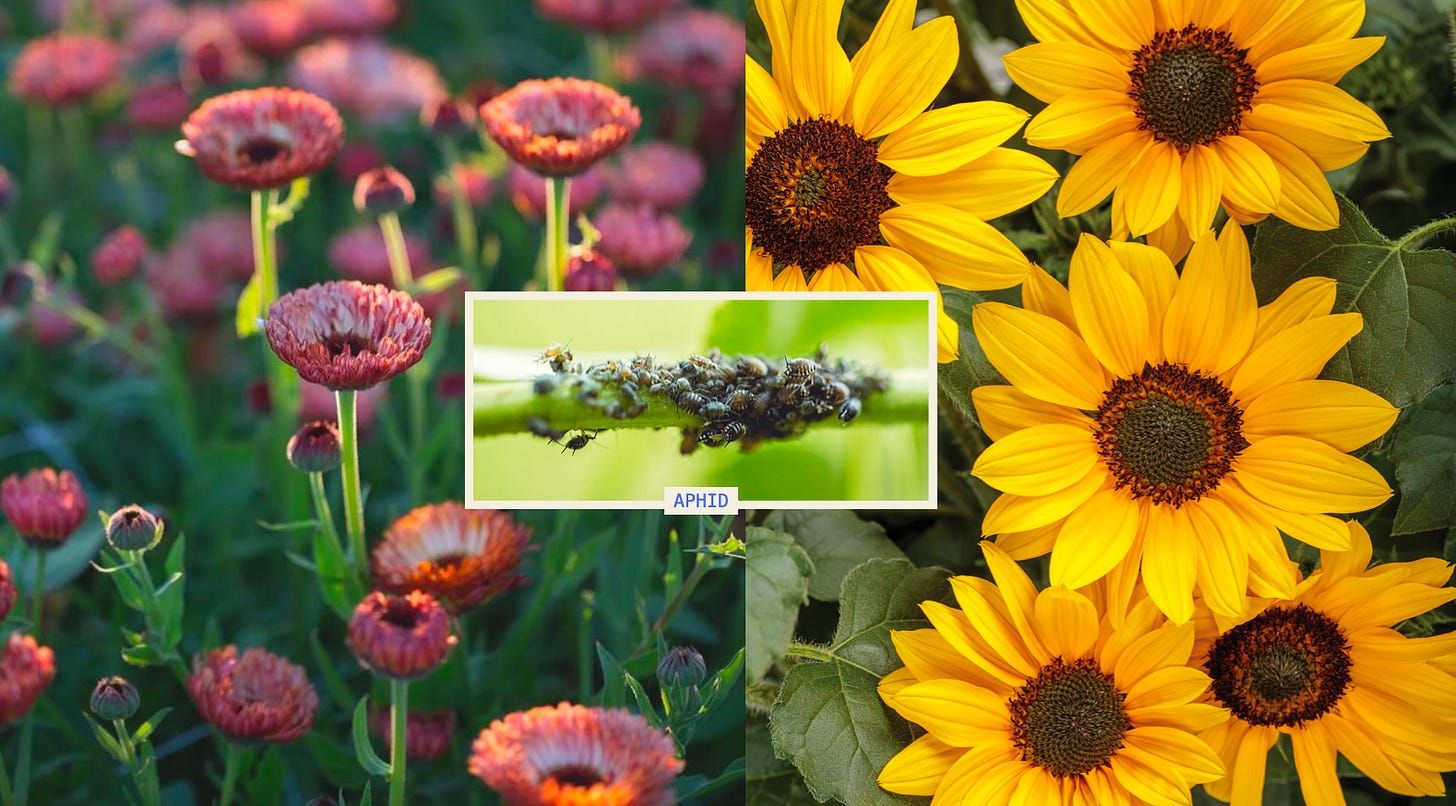a few housekeeping things before we begin —
📆 here is my dynamic garden calendar in case you need assistance building your spring, summer & fall gardens!
🌱 if you are needing help with seed starting, i made a lil class for that!
🛠 if you are local & want Team Floricult™ to build you a new garden this year, email me to get a consult scheduled for march. we are booking up & currently scheduling construction for may and june.
🚛 Team Floricult™ is on the search for a 5x8 or 6x10 enclosed cargo trailer if you know of one!
🦟 “Wasps, Your New Favorite Party Topic” is a required reading for this topic.
🌸 march garden club is fast upon us because february is short! become a paid subscriber & get emailed access instructions right away :)

TRAP CROPS
Trap crops are, in my small mind, a more realistic solution to managing pests in the garden than what we commonly refer to as traditional ‘companion planting.’
While I like the idea that a bad bug would hate a plant so very much that it would leave not only the hated plant but your entire garden, I’ve met living things before. And typically, distraction with something yummy is better than yelling GO AWAY.
(Sidenote: Companion planting can be very effective. I’m simply illustrating the difference in approach. Also, some companion planting strategies are not for pest management, but rather to improve the taste and resilience of their neighbor!)
In addition to planting a few sacrificial plants to protect the many, this is A TREAT for chickens if you’ve got ‘em (an aphid-encrusted leaf? yum)🐔 — and a spectacular activity for curious children.
If you are a parent, may I suggest putting your children in charge of the trap crops? They will inspect them far more closely than you will, and getting lil kiddos comfortable with picking bugs off and dropping them into a cup of water is an A+ experience. This will also help your kids adjust to the idea that some plants die “for a good purpose” and I like to think this contributes to their becoming resilient adults who won’t take garden failure so personally later in life.
WHAT’S THE RIGHT WAY TO ‘TRAP CROP’?
Trap cropping is extraordinarily simple, so don’t get overwhelmed by this email. In general, there are two ways farmers tend to implement this strategy:
Plant a more-desirable vegetable at the same time as the desired crop, so that pests will eat the ‘trap crop’ rather than the ‘cash crop.’
Just plant extra of your crop, but plant it 2-4 weeks ahead of time so that the pest will go after the more advanced plant.
WHAT DO I DO ONCE MY PESTS ARE ON THE TRAP CROP?
It depends on the pest and honestly, your intuition. Large scale farmers typically soak the trap crop in pesticides once pests arrive, but I don’t use any pesticide, and I am a big fan of manual removal because it is both interesting and safe.
As examples: For aphids, they are so itty bitty and cluster in small areas, I would cut the infested part off and leave the rest of the plant to continue to attract them. For stink bugs, leaf-footed bugs, and harlequins, these are so large that I would just pick/knock them off into a cup of water to drown. For flea beetles, I would pull out the entire radish or mustard and replant a few seeds in its place, since those trap crops regrow swiftly. For squash vine borers, they come straight from hell, so I would cut the leaves off where I see eggs, but then pull up the entire plant once the larvae is in the vines.
*It’s important to note that there is NO amount of trap cropping, pesticide use, or companion plant integration that compares to the effectiveness of going to check on your babies and just removing what you see by hand. For big things, I just knock them off into a cup. For little guys (aphids, thrips) I use a wet q-tip because they stick to it. Sometimes I’ll bring tweezers out if it’s tricky. Learn to luv the bug. 🪲 And also learn to not freak out if you see a few thrips or aphids here or there! Very small populations are great for your garden, and attract predatory bugs that keep everybody in check. What you want is a thriving ecosystem, not a sterile environment.
WHERE DO I PUT MY TRAP CROPS?
Opinions on this abound. Many people say to put the trap crop 6-12 feet away from the vegetable it’s protecting. I personally find this pretty far, as do others — because “intercropping” is another common approach. It depends on which plant you’re using, so I’ve made my suggestions below. It’s worth researching further if you have a substantial issue with a particular pest every year.

CHOOSING YOUR TRAP CROPS
You do not need to plant every trap crop listed below — just choose based on which pests you typically struggle with. However, you may find they all already had a place planned in your garden — and you could plant extra, knowing they are high-target vegetables for specific pests. Two birds one stone.
I have taken the liberty to rank them based on their # of kills, which is shocking because I play zero video games.
Blue Hubbard Squash ☠️☠️☠️☠️
…will take out squash bugs, squash vine borer, and spotted and striped cucumber beetles. They are a vining plant though (14’) but don’t worry, you’ll ideally be pulling out the plants once they’ve ‘caught’ bugs and won’t get this size.
My method: I will be planting these out a few weeks before my other squash & zucchinis, and planting them a few feet away. I am plagued with squash vine borers and I want them to have an obvious, better plant to eat.
Nasturtium ☠️☠️☠️☠️
…is delicious to Flea Beatles, Cucumber Beetles, Squash Vine Borers, and Aphids. I would say it is our generation’s marigold. Our moms used to plant marigolds all over all the gardens, and I now do this but with nasturtiums. They are working double time: the whole plant is edible and I love the flowers and leaves in salads. (But not the buggy ones, hehe.)
My method: I will be planting these EVERYWHERE per usual, and this year I will be planting them underneath my tomatoes to help shade the dirt & keep it moist.
Radish ☠️☠️☠️☠️
…will attract Flea beetles, Cabbage and Root Maggots, and Harlequin bugs.
My method: I go outside with a packet of radishes every 2 weeks in the summer and just stick seeds in the dirt wherever there is a couple inches of dead space. This has kept flea beetles almost entirely out of my garden, and I will be intentionally putting more around my kale to 🙅🏻♀️ the harlequins. They luv the kale.
Marigold ☠️☠️☠️
Okay this is a trap crop while simultaneously repelling many others. It will attract Thrips, Aphids, and Nematodes — but it will also repel Mexican bean beetles, cabbage moths, potato bugs, squash bugs, and maggots. Hypothetically.
My method: I don’t plant a lot of marigolds because I am lucky to not struggle with Aphids, and I prefer Nasturtiums and Calendula instead for that work. But, if you do, these work great at the base of tomatoes and anything else susceptible.
Cherry Tomatoes & Okra ☠️☠️☠️
Both of these will attract Stink Bugs, Leaf-Footed Bugs, & Aphids. I honestly do not notice much damage from Stink Bugs, despite their prevalence earning them the title of North Carolina’s State Bird (a joke that never gets old). I notice even less from Leaf-Footed bugs.
My method: I haven’t used either of these as trap crops and am not planning on it, but if I was, I’d probably plant 2-3 of each in a separate part of the yard in hopes of luring all the bugs away from my entire raised bed area.
Mustard Plants ☠️
…will distract Cabbage Worms from your other brassica plants. This is helpful if you don’t have enough wasps to snatch ‘em already. [If you have not read my post on Wasps it is an absolute must]
Zinnias ☠️
If you are plagued by Japanese Beetles, I am deeply sorry. I have noticed they are absolutely atrocious anywhere with large areas of grass. Did you know that grubs are Japanese Beetles in larvae form? I recommend choosing a modern solution and buying trap bags. 😕
You can also try Borage and Evening Primrose, although people have varying luck with them. I’ve also heard Raspberry and Blackberry bushes are exceptional, but this is typically what we’re trying to protect so I did not include them.
Calendula & Sunflowers ☠️
…will pull all your Aphids to them! I put Calendula everywhere, and dry the flower heads for tea. I also just discovered last year that if you put sunflowers throughout your raised beds, you can use them as bean poles and have beans or peas grow up them!
To sum up, here is a little list you can reference if trying to manage one or two particular pests.
This concludes my trap crop research, if you have any additions you’d like to suggest to the list or advice you can give on the subject, please leave a comment!
And if you did not read the Wasp newsletter yet, now is the time to do that. ✨
Lauren
“You can do it like it’s a great weight on you, or you can do it like it’s part of the dance.” - Ram Dass


















Love your content! I like the more unique topics!
SO HELPFUL